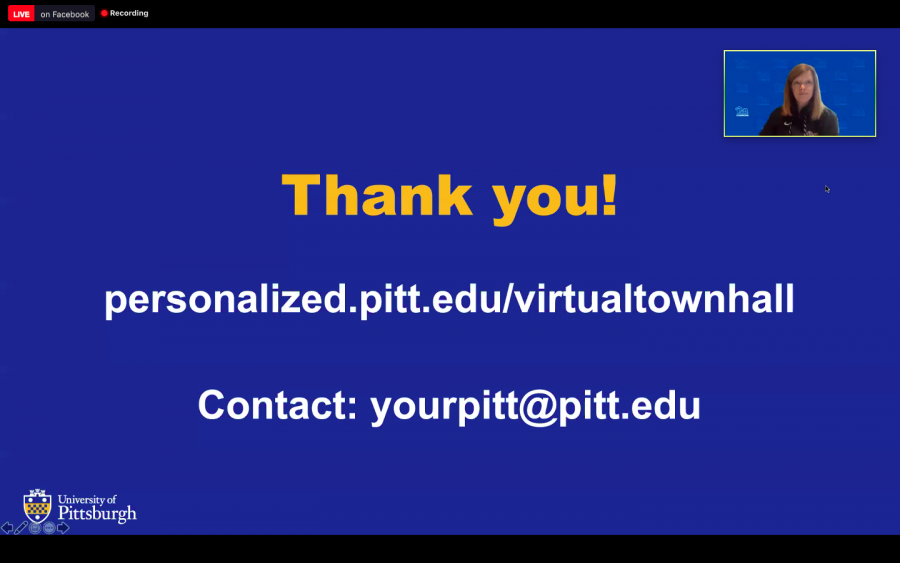Administrators provide updates on classes, dining, housing
Julia Spears, the associate vice provost for academic innovation, moderated Thursday’s virtual town hall.
June 18, 2020
Pitt students will not be required to return to campus this fall if they feel unsafe doing so in the midst of the ongoing COVID-19 pandemic, University officials said Thursday.
“The way that Flex@Pitt is designed is that students can engage in all of their classes remotely, completely remotely, if they so desire or if their current health status requires that they do so,” Joe McCarthy, the vice provost for undergraduate studies, said. “We’re going to endeavor to have an in-person experience, or let’s call it a ‘live’ experience, for all students within their classes once per week.”
McCarthy and other top administrators spoke at a Thursday afternoon town hall about changes to classes, dining and housing during the upcoming semester. Julia Spears, the associate vice provost for academic innovation, moderated the event.
Through Flex@Pitt, students will be able to attend classes at least once a week in person, remotely through livestreams or watching recordings after the fact. According to Delo Blough, the director of the Office of International Services, these resources will also be available to international students who are unable to return to campus for the fall term.
“To the extent possible, given connectivity and time zone differences that are around the world, we expect that we’ll be able to offer all the options available to any other student to an international student who is outside of the country,” Blough said.
For the students who are attending in-person lessons, McCarthy said, the times and locations for classes currently displayed on PeopleSoft may soon change. With classroom capacities being reduced by at least 50%, he said the University is taking the extra step of reassigning classrooms so students can be safely distant from one another. Timing will also be adjusted to allow for more time between class periods.
“Those students that are physically present on campus will have a little bit more time between classes because we’re going to be using some non-traditional spaces for classroom activities so we can have that safe distance between students,” McCarthy said.
Similar capacity restrictions are in place for campus dining locations, according to Steve Anderson, the associate dean of students and director of the Office of Residence Life. He said physical distancing will be implemented at the two on-campus dining halls, Market Central and The Perch.
“What our returning students have known as Market and The Perch will be different as far as being able to sit-down and dine,” Anderson said. “Those are all being worked out, but we have a plan to maintain safety and wellness of the community in those spaces.”
Changes coming to the dining halls include a different layout for food and utensils to mitigate heavy traffic, as well as additional to-go options. Anderson said more details about dining will be released around mid-July.
Anderson also said residence halls will be rearranged to accommodate social distancing restrictions.
“We are working on de-densifying our residence halls that have communal bathrooms, and we are able to accommodate all students that have guaranteed housing,” Anderson said. “We believe those assignments will go out around the second week of July.”
Kenyon Bonner, the vice provost and dean of students, said he hopes that students will keep to these safety precautions so the community will stay healthy. He said he has been working with students on a contract for community members to sign, indicating they will hold to the restrictions.
“The approach is really more about social norming and creating an environment where students are more likely to understand why compliance is important, whether that’s wearing a face mask or social distancing,” Bonner said.
In the event that students become sick in the fall, Anderson said the University has developed quarantine locations to ensure that students have access to all the resources they need, while also protecting healthy students from the virus.
“We are also developing a response team that would be supporting them, and making sure that if they need anything while they’re in isolation, that we would be able to respond and make sure those things are addressed,” Anderson said.
McCarthy said as students plan for a possible return to campus, the best thing they can do is meet with their adviser to ensure they have the latest information on changing class locations and times.
“That’ll inform us, it’ll give us the information to continue confidently, building that classroom assignments done really in the next two to three weeks,” McCarthy said.








